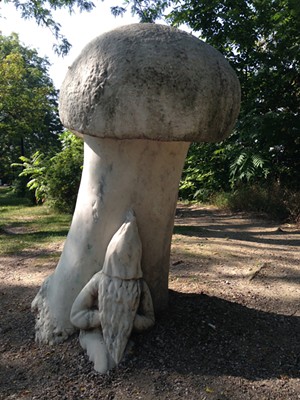
- Ken Picard
This week's WTF column answers two readers' seemingly unrelated questions: First, what's up with the mushroom-and-napping-gnome sculpture on Burlington's Battery Street? Second, why is a rest area on Interstate 89 north in Waterbury surrounded by a chain-link fence? Surprisingly, the answers share a common thread.
Let's begin with the story behind the stone 'shroom and the drowsy dwarf. The Tolkienesque totem, which sits across the street from the Hilton Burlington, is the work of Robert Vesely, a sculptor who studied under and worked with the late Paul Aschenbach.* Aschenbach, a University of Vermont professor, who grew up in Randolph, was renowned for creating large stone and metal public artworks.
The sculpture's exact date is unknown, but Doreen Kraft, executive director of Burlington City Arts, suggests it was likely part of a series of waterfront works that Aschenbach created in the early 1970s. They include a group of five white marble carvings sited along Battery Street.
Much of Aschenbach's career involved creating public art, often in collaboration with other sculptors. In the early 1990s, he and his UVM students worked together on a series of marble carvings still visible along the Burlington Bike Path near the wastewater treatment plant. They depict such figures as a Pegasus, a mermaid, a merman, Champ, the sun, a canoe, a lighthouse and a pair of Rollerblades.
Aschenbach's larger pieces can be found throughout the Burlington area. They include "Tree of Knowledge" (1961) at the entrance to UVM's Bailey/Howe Library; "Three Children" (1968), a steel sculpture in front of the First Congregational Church; and "Road to Emmaus" (1990), a black marble sculpture on the campus of Saint Michael's College. Aschenbach died in 1994, only a year after the Vermont Arts Council recognized him with a lifetime achievement in the arts award.
As to why the sculptor's mycological creation on Battery Street resembles a marble manhood, blame nature. It would be a tall order to sculpt such a mushroom and not have it resemble a phallus.
What does all this have to do with a rest area on I-89 whose once-open hillside and neighboring woods are now fenced off from public access? Turns out that Aschenbach organized three international artists' symposia in Vermont: in 1969, 1971 and 1990. The first two had the express purpose of creating public art for interstate motorists. Called "Sculpture on the Highway," the 18 massive pieces were created by 11 artists from nine countries and installed at rest stops along the then-newly constructed I-89 and I-91 interstates between Massachusetts and the Canadian border. Aschenbach himself created the sculpture at the Waterbury rest area, which resembles a huge spoon resting on its side.
"Village greens, roadside shrines, monumental sculptures — they all go toward making travel digestible," Aschenbach told a Chicago Tribune reporter for a November 14, 1971, story about the roadside art, "killing that terrible instinct we have of always moving in a hurry."
If you've never seen or heard of these sculptures, it's understandable. Scott Rogers, maintenance and operations bureau director for the Vermont Agency of Transportation, explains via email that he only learned of them in 2015. That was after two private citizens — who were interested in renovating and possibly relocating some of the works to more publicly accessible sites — had approached state curator David Schütz and Michael Obuchowski, then commissioner of Buildings and General Services.
Eleven of the sculptures are at rest stops that VTrans has since closed, Rogers reports, and at least one of the original 18 no longer exists. Many, never maintained, are now overgrown with vegetation. Only two — at the Williston rest area on I-89 south and the Hartland rest area on I-91 south — are still accessible.
What became of the plan to move the rest of the sculptures? It never came to pass, owing to limited funding and a lack of political will, Rogers explains. Most of the huge sculptures are still out there, "lost to time," he says.
Aschenbach's sculpture in Waterbury is still visible but now inaccessible behind a chain-link fence that the state erected just a few years ago — though not to protect it from vandals and thieves. VTrans and local law enforcement say the still-open roadside pull-off, which is unstaffed and offers no facilities, became a locus for illegal and unsanitary activities, including drug dealing, narcotics use, sexual trysts and noisy late-night parties. The interlopers left behind piles of trash and human waste.
It's impossible to say how Aschenbach would have felt about his sculpture being used as a place to get buzzed and hook up. But, based on one published account, he might not have objected too strenuously. According to that 1971 Tribune story, the artist eschewed the "don't touch" attitude that often surrounds artworks — public or otherwise.
Instead, Aschenbach argued, people should engage with public art in visual and tactile ways — even if that meant altering or defacing it. As he told the Tribune, "A little graffiti lends a patina to sculpture and, really, how can you abuse a concrete block that weighs 80 tons? It's impossible."
The sculptor might seem to have foreseen the fate of one of his most visible public installations: a rectangular arrangement of 30 or so massive granite slabs that once stood, Stonehenge-like, beside the now-abandoned Moran Plant in Burlington. Created by a group of artists during the 1990 international sculpture symposium, that piece was frequently tagged with graffiti until the city finally dismantled it in 2014.
Correction, September 28, 2017: An earlier version of this story misidentified Paul Aschenbach as the artist who carved the sculpture. Though he oversaw the waterfront art project, one of his students actually carved the sculpture.










Comments (4)
Showing 1-4 of 4
Comments are closed.
From 2014-2020, Seven Days allowed readers to comment on all stories posted on our website. While we've appreciated the suggestions and insights, right now Seven Days is prioritizing our core mission — producing high-quality, responsible local journalism — over moderating online debates between readers.
To criticize, correct or praise our reporting, please send us a letter to the editor or send us a tip. We’ll check it out and report the results.
Online comments may return when we have better tech tools for managing them. Thanks for reading.